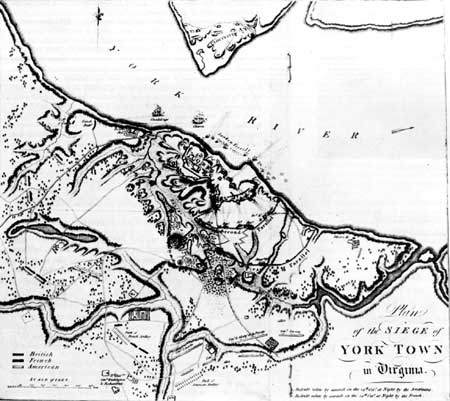|
YORKTOWN Climax of the Revolution |
 |
7. THE BOMBARDMENT
Some of the allied batteries were ready to fire by the afternoon of October 9. All movements and activities up to this time had been merely preliminary. The siege of Yorktown now settled into deadly earnest, with a heavy and continuous bombardment of the British position. Additional batteries took up the chorus on the following morning. Surgeon Thacher, of the American Army, in the intervals of caring for the wounded, watched the terrible spectacle.

PLAN OF THE SIEGE OF YORKTOWN IN VIRGINIA
This map of the siege of Yorktown appeared in the
London edition of Tarleton's Campaigns, 1787. The cartographer
has not been identified, but was probably with the British Army during
the siege. The British and allied entrenchments are clearly shown, with
the allied encampments in rear of the latter.
From the 10th to the 15th, a tremendous and incessant firing from the American and French batteries is kept up, and the enemy return the fire, but with little effect. A red hot shell from the French battery set fire to the Charon, a British 44 gun ship, and two or three smaller vessels at anchor in the river, which were consumed in the night. From the bank of the river, I had a fine view of this splendid conflagration. The ships were enwrapped in a torrent of fire, which spreading with vivid brightness among the combustible rigging, and running with amazing rapidity to the tops of the several masts, while all around was thunder and lightning from our numerous cannon and mortars, and in the darkness of night, presented one of the most sublime and magnificent spectacles which can be imagined. Some of our shells, overreaching the town, are seen to fall into the river, and bursting, throw up columns of water like the spouting of the monsters of the deep. We have now made further approaches to the town, by throwing up a second parallel line, and batteries within about three hundred yards; this was effected in the night, and at daylight the enemy were roused to the greatest exertions, the engines of war have raged with redoubled fury and destruction on both sides, no cessation day or night. The French had two officers wounded, and fifteen men killed or wounded, and among the Americans, two or three were wounded. I assisted in amputating a man's thigh. The siege is daily becoming more and more formidable and alarming, and his Lordship must view his situation as extremely critical, if not desperate.
Being in the trenches every other night and day, I have a fine opportunity of witnessing the sublime and stupendous scene which is continually exhibiting. The bomb shells from the besiegers and the besieged are incessantly crossing each others' path in the air. They are clearly visible in the form of a black ball in the day, but in the night, they appear like fiery meteors with blazing tails, most beautifully brilliant, ascending majestically from the mortar to a certain altitude, and gradually descending to the spot where they are destined to execute their work of destruction. It is astonishing with what accuracy an experienced gunner will make his calculations, that a shell shall fall within a few feet of a given point, and burst at the precise time, though at a great distance. When a shell falls, it whirls round, burrows, and excavates the earth to a considerable extent, and bursting, makes dreadful havoc around. I have more than once witnessed fragments of the mangled bodies and limbs of the British soldiers thrown into the air by the bursting of our shells, and by one from the enemy, Captain White, of the seventh Massachusetts regiment, and one soldier were killed, and another wounded near where I was standing. About twelve or fourteen men have been killed or wounded within twenty-four hours; I attended at the hospital, amputated a man's arm, and assisted in dressing a number of wounds.
JAMES THACHER,
A Military Journal during the American Revolutionary War.

|

|
|
|
Last Modified: Fri, Sep 26 2003 10:00:00 pm PDT |

